- While the threat of extinction looms closer than ever for many species, 2015 was not all gloom.
- Scientists discovered thousands of new species this year, some seen and classified for the first time and completely novel to science.
- Below are Mongabay’s top picks for species discoveries in 2015.
While the threat of extinction looms closer than ever for many species, 2015 was not all gloom. Scientists discovered thousands of new species this year, some seen and classified for the first time and completely novel to science. This includes 74 species of beetles that were discovered on a single Hawaiian volcano. Others, like the African golden wolf, were identified as “new” species thanks to advanced genetic analysis.
Below are Mongabay’s top picks for species discoveries in 2015.
Note: for each entry, the publication and author are listed in parentheses.
1. Two new primate species
White-cheeked macaque (Mongabay, by Morgan Erickson-Davis)

Scientists discovered these monkeys in a remote and under-explored part of Tibet. Caught only on camera, the monkeys have an odd distinctive feature that sets them apart from four other monkeys in the region: these macaques have differently shaped and colored penis and scrotums. The researchers classified and named the white-cheeked macaques (Macaca leucogenys) based on photographs alone. But experts say that analysis of the macaque’s DNA would be necessary to confirm their “novel” status. The newly described monkey is threatened by local hunting and construction.
Urubamba brown titi monkey (Mongabay, by Jeremy Hance)

Jan Vermeer had long suspected that a specimen of a titi monkey at the American Museum of Natural History had been misidentified. So in 2013, he set out on a six-week expedition in the Peruvian amazon to sort out the monkey’s true taxonomic identity. Vermeer’s team successfully discovered individuals of the new species of the titis on the western edge of the Urubamba River. The habitat of the Urubamba brown titi monkey (Callicebus urubambensis) is not immediately under threat. But illegal gold-mining and rampant logging is rife southeast of the new monkey’s habitat.
2. Six new species of clawed frogs discovered in Sub-Saharan Africa (Mongabay, by Mike Gaworecki)

Researchers in west and central sub-Saharan Africa discovered six new species of the African clawed frog. These frogs, which have flat bodies and vocal organs that can produce sound underwater, are commonly used as a study subject by developmental biologists and for other research purposes.
3. New punkrocker frog that can change skin texture (Mongabay, by Shreya Dasgupta)

The shape-shifting mutable rainfrog (Pristimantis mutabilis) can change its skin texture. Discovered in north-central Ecuador, the tiny frog — smaller than a U.S. quarter in size — can make its skin smooth or spiny based on the environment it is in. Since amphibian taxonomists have traditionally depended on skin texture, and the presence or absence of wart-like features on the skin to identify and describe new amphibian species, the discovery of a shape-shifting trait in frogs could change the way taxonomists work.
4. African golden wolf (Mongabay, by Morgan Erickson-Davis)
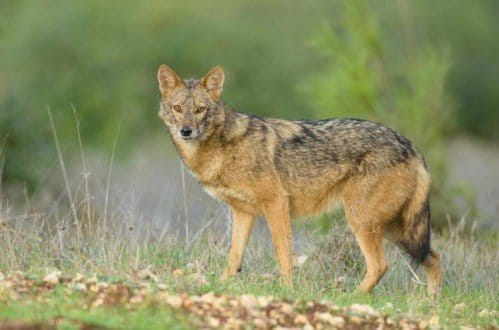
The number of wolves in the world shot up to 36 with the discovery of this new species, the African golden wolf (Canis anthus). Previously grouped with the golden jackals, genetic analysis revealed that they have more in common with the gray wolves and coyotes than the Eurasian golden jackals. “This represents the first discovery of a ‘new’ canid species in Africa in over 150 years,” Klaus-Peter Koepfli of the Smithsonian Conservation Biology Institute in Washington, DC, told Mongabay.
5. Giant carnivorous rat with long pubic hair (Mongabay, by Rhett Butler)
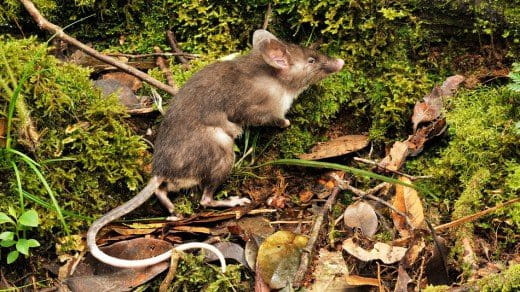
In a remote part of Sulawesi, an Indonesian Island, scientists discovered an unusual rodent — a shrew rat with especially long pubic hair. The rat was captured in an overnight trap on Sulawesi’s Mount Dako by a team led by Museum Victoria’s Kevin Rowe, a mammologist, who has discovered other rats in Sulawesi. The team named the rat Hyorhinomys stuempkei.
6. Hundreds of new species discovered in the Eastern Himalayas (Mongabay, by Mike Gaworecki)

This year, scientists from the World Wildlife Fund (WWF) released a report that unveiled the discovery of more than 200 new species in the Eastern Himalayas by various scientists in recent years. Among these, is a new species of the dwarf snakehead fish discovered in West Bengal, India, that can survive on land for up to four days. Others include a “bejeweled” pit viper and a blue-eyed frog. “With the risk of climate change coupled with increasing human pressures and threats, we must continue to enhance monitoring of the Himalayan ecosystem and equip ourselves with tools to adapt to the impacts of climate change,” Lyonpo Yeshey Dorji, Minister for Agriculture and Forests in Bhutan, wrote in the report.
7. New species of giant Galapagos Tortoise (Livescience, by Laura Geggel)

For a long time, scientists thought that the two populations of giant Galapagos tortoises living on opposite sides of the island of Santa Cruz were the same species Chelonoidis porteri. But a new genetic analysis has revealed that the two populations are in fact two separate species. While the tortoises living on the western side of the island continue to be Chelonoidis porteri, the ones living on the eastern side have been named Chelonoidis donfaustoi. “Right now, the western Santa Cruz tortoise population is booming, with about 2,000 members, whereas the eastern species has only about 250 individuals,” Adalgisa Caccone of Yale University told Livescience. “Now that researchers know the eastern group is a separate species, it may receive increased habitat protection.”
8. 74 new beetle species found on a Hawaiian Island (Ithacajournal, by Andrew Casler)

Within the limits of the Haleakala volcano on Maui Island in Hawaii, James Liebherr of the Cornell University discovered 116 species of round-waisted beetles, including 74 new to science. This group of beetles belong to Mecyclothorax. “It’s not just that he found 74 new species, which is in-and-of-itself remarkable, but he found them all in one volcano, and he was able to define these different micro-regions across the volcano — it’s just astounding,” University of Hawaii Insect Museum Director Daniel Rubinoff told Ithacajournal.
9. Ruby seadragon (Mongabay, by Jeremy Hance)

Off the southern Australian coastline, scientists discovered an enchanting cousin of the seahourse — a bright red-colored sea dragon. They named it the ruby seadragon (Phyllopteryx dewysea). The new seadragon joins the exclusive club of the only other two seadragon species known so far: the leafy seadragon (Phycodurus eques) and the weedy seadragon (Phyllopteryx taeniolatus).
10. More than 100 new marine species discovered in the Philippines (Science, by Annick Laurent)

A marine expedition by American and Filipino scientists on the Verde Island Passage in the Philippines uncovered around 100 new species of barnacles, urchins and nudibranchs that are likely new to science. One of the highlights was the discovery of more than 40 species of vibrant, poisonous sea slugs important for biomedical research. Most of the new species had never been found before because of technological limitations during past expeditions, Terry Gosliner of the California Academy of Sciences, told Science.
11. Omura’s whale found living in the wild (Mongabay, by Rebecca Kessler)
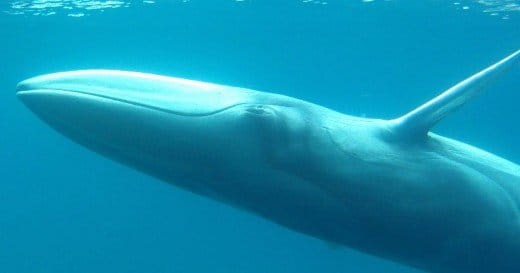
For the first time ever, scientists spotted live individuals of a mysterious whale previously known only from old, dead specimens. In a study published this year, researchers write about observing the elusive Omura’s whale (Balaenoptera omurai) 44 times in total. The team caught the animals feeding on zooplankton, breaching and defecating — first-ever such observations of the whale species. Since very little is known about the species, the whale’s conservation status is not yet confirmed.
12. New colorful crayfish species discovered in pet shop (Mongabay, by Jeremy Hance)
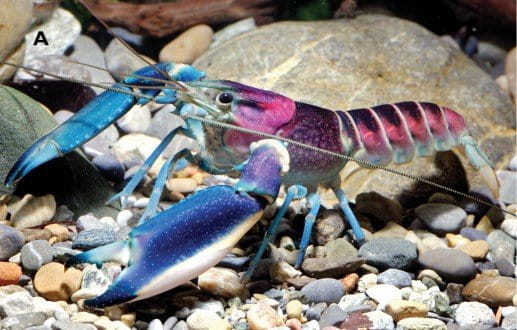
After spotting a vibrant red, white and blue crayfish in Japanese pet shops, independent researcher, Christian Lukhuap, tracked the crayfish to creeks in remote West Papua, Indonesia. He gathered some specimen and described the spectacularly colored animal in Zookeys earlier this year. Lukhuap observed that the males were more brightly colored than the females and named the species Cherax pulcher, pulcher meaning beautiful in Latin. Lukhuap fears that the practice of collecting this species for trade is not sustainable, and its popularity could spell doom for the species.
13. Ninja Lanternshark (Hakai Magazine, by Jason Bittel)
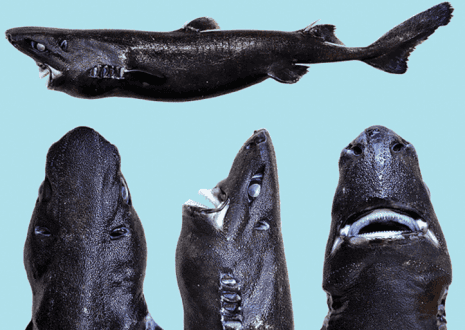
Peter Benchley, author of Jaws, now has a shark named after him — Etmopterus benchleyi. The first lanternshark to be discovered off of Central America, the shark has special cells that allows it to glow in the dark, and has jet black skin. The shark’s common name — Ninja lanternshark — arose from a discussion that the lead researcher had with her 8-year old cousins.
14. New species of Ceratioid anglerfish (CNN, by Ben Brumfield)
![The newly discovered anglerfish species [Genus Lasiognathus Regan] lives in complete darkness at depths of 1000-1,500 meters. Photo by Pietsch and Sutton 2015.](https://imgs.mongabay.com/wp-content/uploads/sites/20/2015/12/02225816/anglerfish.gif)
Scientists discovered a never-before seen species of a Ceratioid anglerfish from the deep waters of the northern Gulf of Mexico. The odd-looking fish has a long, angular structure on its head that resembles a fishing-pole. It uses this structure to lure other fish to its jaws. The new fish species [Genus Lasiognathus Regan] lives in complete darkness at depths of 1000-1,500 meters.
15. First ever biofluorescent sea turtle discovered in Solomon Islands (Mongabay, by Mike Gaworecki)

While not a “new species”, this was nonetheless a noteworthy discovery. This year, scientists reported observing the first-ever glow-in-the-dark sea turtle. While out filming biofluorescent corals off the coast of the Solomon Islands, National Geographic Emerging Explorer David Gruber discovered the glowing hawksbill sea turtle. Why these turtles developed biofluorescence is still a mystery. Populations of hawksbill turtles have collapsed worldwide, and doing further research on them would be very difficult, according to Gruber.
16. New carnivorous plant species discovered on Facebook (The Telegraph, by Melanie Hall)

This huge carnivorous plant was identified as a new species only after an amateur researcher posted its photo on Facebook. The picture was taken on a mountain top in Minas Gerais, southeastern Brazil, and experts named it Drosera magnifica, or magnificent sundew, and described it as the second-largest carnivorous plant in the Americas. The mangnificent sundew is “the first plant species to be recorded as being discovered through photographs on a social network,” according to authors of the paper published in Phytotaxa.
17. New coffee tree species discovered in Honduras, is Critically Endangered

During an expedition to document plant diversity in the Cusuco National Park in north-western Honduras, botanists discovered two individuals of an unknown tree species. The trees were 10-meters tall and covered with cream-colored flowers and cherry-like fruits. Experts identified them as trees that belong to the coffee family (Rubiaceae), and named it Sommera cusucoana after their only known location so far, the Cusuco National Park. ” Although the range of Sommera cusucoana has yet to be established, this relatively conspicuous and distinctive species has not been noted elsewhere within the Park, and its proposed conservation status must be Critically Endangered,” the authors write in their paper published in PhytoKeys.
18. Citizen scientists discover two new species of blue-flowered legumes (Pensoft blog)
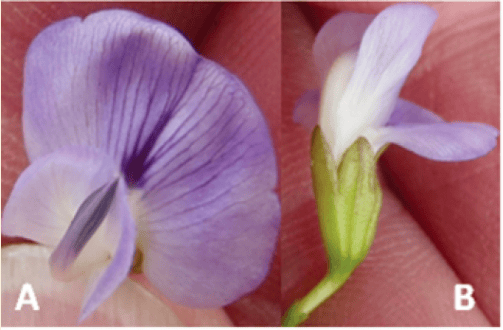
A citizen scientist group called the Outramps discovered two beautiful blue-flowered legumes in the Western Cape province of South Africa, which they believed were new to science. Experts from the University of Cape Town then identified the plants as two new members of the legume genus Psoralea. They named the two species after the discoverers of the plants — Di’s Psoralea or Psoralea diturnerae in honor of group leader Dianne, and Nicky’s Psoralea or P. vanberkelae after a photographer in the group Nicky van Berkel. Charles Stirton told Pensoft blog, “Without the persistence and enthusiasm of the Outrampers, we would never have picked up these species in our studies as they were in areas we would not have accessed in our planned field trips. It is not uncommon for highly localised species to be overlooked by monographers”.
19. Scientists name a new plant genus in honor of Sir David Attenborough (United Press International, by Brooks Hays)

In the forests of Gabon, Gabonese and French scientists discovered a new genus of flowering plants from the custard apple family. The experts named the genus Sirdavidia to honor Sir David Attenborough. “I was really surprised when I realised that no one has named a genus after him before, so I found this discovery an excellent opportunity to honor him with a genus name,” Thomas Couvreur, Researcher at Institut de Recherche pour le Développement, France, said in a statement. The rarity of the newly named plants suggest that these may be endangered.
20. Researchers discover two new plant species unique to Singapore (Asia One, by Audrey Tan)

Biologists from the Singapore Botanic Gardens discovered two new species of flowering herbs growing in lowland forests of Singapore. They named the plants Hanguana rubinea and Hanguana triangulata “The two new Hanguana plant species have red and white berries, our national colours,” Minister for National Development Khaw Boon Wan wrote in a blog post, adding that they are “nature’s timely gift” to Singapore during its 50th anniversary.” Both species are considered to be critically endangered.